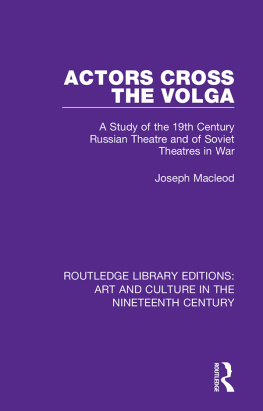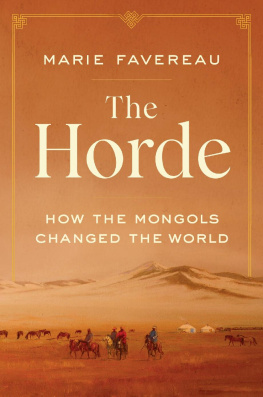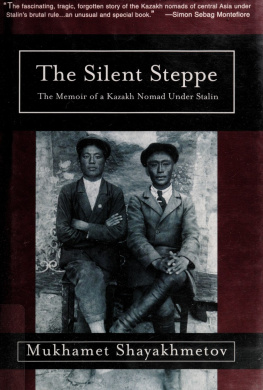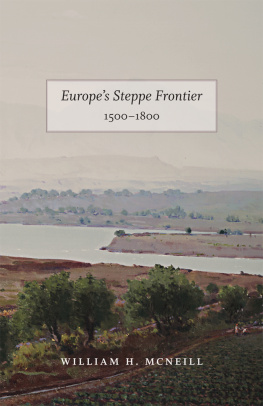Law and Custom
in the Steppe
Law and Custom
in the Steppe
The Kazakhs of the Middle Horde and
Russian Colonialism in the Nineteenth Century
VIRGINIA MARTIN
First Published in 2001
by Routledge Corzon
Richmond, Surrey
Transferred to Digital Printing 2005
http://www.routledgecurzon.co.uk
2001 Virginia Martin
Typeset in Stempel Garamond by LaserScript Ltd, Mitcham, Surrey
All rights reserved. No part of this book may be reprinted or reproduced or
utilised in any form or by any electronic, mechanical, or other means, now
known or hereafter invented, including photocopying and recording, or in any
information storage or retrieval system, without permission in writing from
the publishers.
British Library Cataloguing in Publication Data
A catalogue record of this book is available from the British Library
Library of Congress Cataloguing in Publication Data
A catalogue record for this book has been requested
ISBN 0700714057
To Kevin and Julia
Acknowledgements
It is with great pleasure that I acknowledge the support of a variety of people and organizations who have encouraged my work on nineteenth century Kazakh history. First, I would like to thank my mentor, dissertation advisor and friend, Professor Azade-Aye Rorlich, who has tirelessly guided the development of my understanding of the history and culture of the Turkic, Muslim peoples of the Russian Empire over the past 11 years. I would not be the scholar that I am today without her example, and I am most grateful for her continued presence in my scholarly and personal life. Charlotte Furth, Gene Cooper, Jack Wills, Paul Knoll and Rudy Koshar also inspired me intellectually and helped shape my scholarship during graduate school, and I thank them for their guidance. Along the way, I have benefitted enormously from the constructive criticism of colleagues across disciplines in the broader field of Russian/Eurasian studies, including Nazif Shahrani, Adeeb Khalid, Paul Werth, Sean Roberts, Willard Sunderland, David Abramson, Bruce Grant, Ed Lazzerini, and Allen Frank, as well as Audrey Altstadt and Al Senn, who sparked my interest in the history of the non-Russians of the Russian Empire at the University of Wisconsin so many years ago. The small but feisty History Department at the University of Alabama in Huntsville has provided the kind of supportive environment that most young academics only dream of, and I am fortunate to call them my colleagues.
I would like to thank Dr. Meruert Abuseitova, Director of the Institute of Oriental Studies in Almaty, Kazakhstan, and Erden Kazhibek, former director of that institute, for sponsoring and encouraging my research work in Almaty during extended stays there in 1993/4 and 1999. Conversations with Nurbolat Masanov, Timur Beisembiev, Rakhmankul Berdibai, and Tursun I. Sultanov guided my thinking in important ways. I received institutional support and encouragement from Vadim Petrovich Kurylev at the Institute of Ethnography in Leningrad/St. Petersburg for my first visit to Almaty in 1991, and again in 1993/4. The following people each generously provided me with access to their institution's holdings: Maria Sandibaeva, Director of TsGARK when I was there in Fall 1993 and Winter/Spring 1994, & Nikolai Petrovich Kropivnitskii, its current Vice-Director; Raisa T. Brimzharova, head of the rare book room of the library of the Academy of Sciences of Kazakhstan; Alla Fedorovna Seitova, Director of the Central State Archive for Film Documents and Audio Recordings of the Republic of Kazakhstan, where I obtained the historical photos included in this manuscript; Nina Pugacheva, Director of GAOO; Nina Flegovtovna Klimova, Director of the Library of the Regional Museum [former library of the Western Siberian Department of the IRGO] in Omsk; and Serafima Igorovna, head of the reading room at RGIA.
For their generous financial support, I am grateful to the International Research and Exchanges Board, Social Science Research Council, University of Southern California, and the Mini-Grant Program at the University of Alabama in Huntsville.
I would like to thank my parents, Andrew and Janet Martin, for their love and support of me and for their intellectual interest in the crazy things I do. Last but not least, I dedicate this book to Kevin and Julia. They have endured my absences, accompanied me on research trips, supported me and believed in me Kevin since I first started on this scholarly adventure, and Julia for only the past few years of it. Through it all they have kept me smiling. I am so thankful to have them by my side.
Note on Terminology
and Transliteration
This study examines the judicial practices of the Middle Horde Kazakhs in the period from 1868 to 1898, and the Russian laws throughout the nineteenth century that sought to change those practices. In Russian historiography before the 1920s, all Kazakhs of the Great [Ul], Middle [Orta] and Little [Kishi] Hordes [zhuz] were referred to as Kirgiz, while the Turkic, nomadic Kyrgyz peoples of present-day Kyrgyzstan were called Kara-Kirgiz [black Kirgiz] or Dikokamennyi Kirgiz [wild mountain Kirgiz]. Kazakh [Qazaq] was a self-appellation not recognized by the Russian imperial administration in the nineteenth century. In this study, the reader should be aware that where Kirgiz is found in my translations of primary sources from the pre-Soviet period, reference is being made to Kazakhs. In no place in this study does the term Kirgiz refer to the Kyrgyz people of present-day Kyrgyzstan.
Transliteration of Russian and Kazakh words into English follows current Library of Congress conventions. Contemporary Kazakh letters are written in a modified form of the Cyrillic alphabet adopted in 1940. For Kazakh Cyrillic letters not found in the Russian Cyrillic alphabet, I follow the transliteration system in Edward Allworth, ed. Nationalities of the Soviet East. Publications and Writing Systems (NY & London: Columbia University Press, 1971), 332. Some of my Kazakh-language sources date to the late nineteenth century, when the Kazakh language was first written in a modified Arabic alphabet (see Allworth, op. cit., 328), but I have used Soviet or post-Soviet era reprints, not the pre-revolutionary originals; my transliteration of these sources is rendered from the Allworth system of Kazakh Cyrillic letters. For simplicity's sake, no distinctions will be made in the different transcription of the Russian [u] and the hard Kazakh [u], nor for the separate soft Russian and Kazakh letters [i]. Because most of the sources cited in this study are in the Russian language, I have retained the Russian spellings and/or renderings of many Kazakh place names and terms. Thus, it is Akmolinsk, not Aqmolla (now Astana). I maintain the Russian-language transliteration of Kazakh (rather than the Kazakh-language Qazaq) in order to be consistent with the bulk of my sources and with the conventions of Western historiography through the present day. Finally, for the sake of avoiding the cluttering of the text with more orthographic marks than necessary, the oft-used words oblast and volost are rendered without the transliterated soft sign ( ), as oblast and volost.












